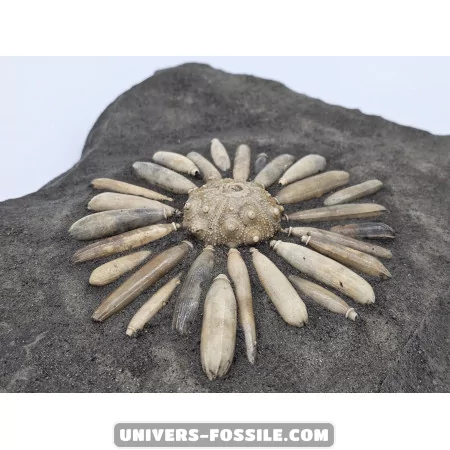Sea Urchin Pseudocidaris mammosa - Echinoderms

Sea Urchin Pseudocidaris mammosa
The fossilized sea urchin Pseudocidaris mammosa is an extinct species of sea urchin that lived millions of years ago. This particular species is known for its distinctive features and its contribution to our understanding of the evolution of marine organisms.
Pseudocidaris mammosa was a medium-sized sea urchin with a globular body covered in spines. What particularly distinguished it were its nipple-shaped tubercles adorning its shell, hence its specific name "mammosa". These tubercles were arranged in a regular pattern on the surface of the sea urchin, giving it a unique appearance among its peers.
Habitat and Distribution
Fossils of Pseudocidaris mammosa have been found in various regions around the world, including Europe, North America, and Asia. It is believed that these sea urchins inhabited shallow marine environments, likely on rocky or sandy seabeds.
Lifestyle
Like most sea urchins, Pseudocidaris mammosa was probably an herbivore, feeding on algae and other organic matter found on the seafloor. Its spines and tubercles served as protection against potential predators as well as for locomotion on the marine.
Sea Urchin Pseudocidaris mammosa
Product
Introduction:
The Sea Urchin Pseudocidaris mammosa is an extinct species of sea urchin that has left behind valuable fossils for study and research. This unique species provides insights into the evolution of marine life and the adaptations of sea urchins over geological time.
Key Features:
- Distinctive anatomical features
- Contribution to understanding evolutionary relationships in sea urchins
- Geographical distribution
Importance in Paleontology:
The fossils of Pseudocidaris mammosa have been crucial in the study of marine organism evolution. Paleontologists and geologists have used the anatomical comparisons with other sea urchin species to unravel evolutionary relationships and adaptations to various marine environments throughout history.
Conclusion:
Pseudocidaris mammosa serves as a fascinating example of an extinct sea urchin species that has enriched our understanding of marine life evolution. By examining these fossils alongside other ancient species, researchers can delve deeper into the evolutionary processes that have influenced modern marine biodiversity.
